Products You May Like
Get full access to Outside Learn, our online education hub featuring in-depth fitness, nutrition, and adventure courses and more than 2,000 instructional videos when you sign up for Outside+
Sign up for Outside+ today.
Choosing the right puffy jacket or midlayer is like adjusting the volume on your speakers—or, in the case of winter sports, dialing in how much body heat you want to retain. A good workhorse insulator lets you customize your comfort across all types of weather depending on its wind protection, fill, water-repellency, and even cargo space (pockets vary). Here are our testers’ all-stars.
Related: How to clean a down jacket without a dryer
How We Test
First, we conducted a thorough dragnet of all the new, fall 2022 puffy jackets and midlayers from big brands and boutique operations alike. Next, we compiled the widest possible assortment of review contenders, from mighty puffs designed for sitting out the coldest temperatures to lightly insulated layers for high-output exercise. Most filled the vast middle ground: midweight, breathable layers for regulating body temperature as you stop and start in a wide variety of conditions. Finally, we distributed these test samples to enthusiasts located across the country, from Alaska to Arizona to Vermont. The test team represented a range of body sizes and activities, including a pregnant runner in Vermont, a size-18 hiker-mom in Colorado’s canyon country, a superfit male skate skier in the northern Rockies, and a desk jockey that logs daily dawn patrols at one of Colorado’s best-loved ski resorts. From November 2021 through May 2022, our crew got out in weather both fair and foul to suss out each jacket’s strengths and weaknesses. Testers then submitted written summaries of each product’s performance and fit characteristics—describing hood adjustments that didn’t pass muster, breathability that underdelivered, fabrics that itched, and much more. The following puffy jackets and midlayers represent the best performers in their respective niches.
Looking for a ski shell? Check out those reviews over here.
Tester Stats
Number of testers: 58
Number of products tested: 99
Total vertical feet: 36,000
Coldest temps: -12°F
Highest elevation: 14,157 feet
Lowest elevation: 50 feet
Snowiest conditions: 2.5 inches per hour
Strongest wind gust: 48 miles per hour
Reviews: The Best Puffy Jackets of 2023
Editor’s Choice: Rab Mythic Ultra Jacket ($475)
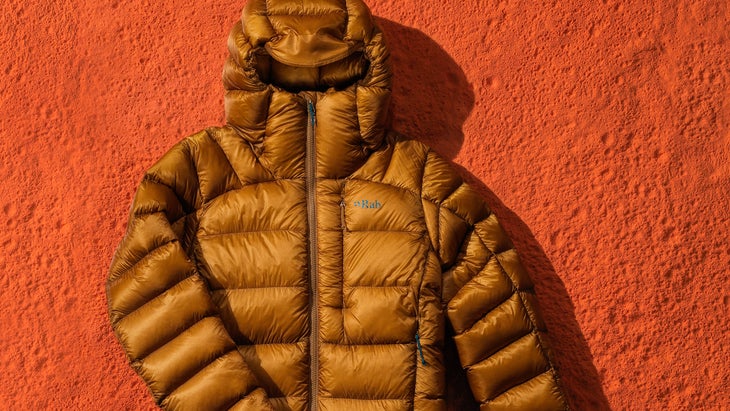
Weight: 1.2 lb (men’s) / 1.1 lb (women’s)
Size: Men’s S-XL / Women’s XS-L
The Rab Mythic Ultra removes the usual trade-off between warmth and packability. Thanks to a generous amount of 900-fill down in offset box-wall baffles, as well as a heat-reflective aluminum scrim (think gauze, but with the ability to bounce body heat back at you), the Mythic Ultra was warm enough to be one tester’s go-to ice climbing belay jacket in the White Mountains of New Hampshire, even on zero-degree days. Despite that insulating power, it weighs a shockingly scant 1.2 pounds and stuffs into a storage sack slightly thicker than a 32-ounce Nalgene. We’ve never seen a jacket as warm as this one that packs so small. That’s thanks to the ultralight 10-denier Pertex Quantum ripstop face fabric holding it all together. Don’t worry: it also proved surprisingly durable. We didn’t bushwhack in this jacket and wouldn’t recommend that type of use; but several testers jammed it into climbing packs next to ice screws, and it never failed. So, the Mythic raised an interesting new question for our testers: When you have a super warm puffy that’s just as light and packable as a less-warm insulator, is there a reason you wouldn’t take the warmer one?
Bottom Line: Super warm puffy that’s as light and packable as less insulating jackets
Editor’s Choice: Arc’teryx Rush Insulated Jacket ($800)
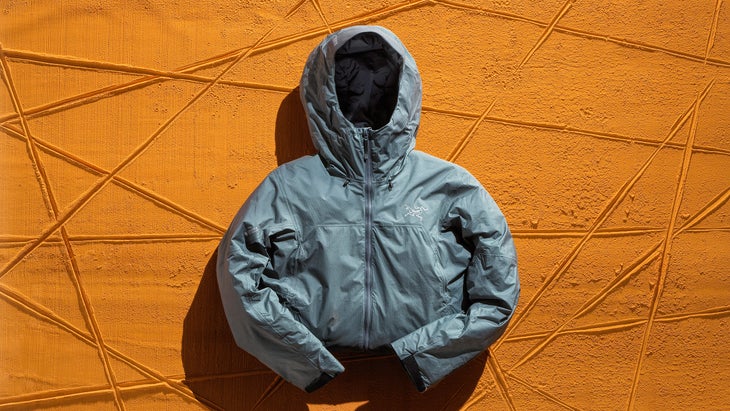
Weight: 1.1 lbs
Size: Men’s S-XXL / Women’s XXS-XXL
The all-new Rush Insulated Jacket proved to be the ultimate transition layer on deep backcountry days, especially those with unpredictable precipitation in the cards. It’s synthetic insulated and water-resistant, and thus kept us dry and warm during quick lunch breaks and long transitions.
The jacket features Arc’teryx’s proprietary 20-denier gridded nylon face fabric, which utilizes a liquid crystal polymer ripstop called Hadron, which is extremely abrasion resistant for its weight. It’s also DWR-treated, so it’s weather-resistant but not full-on waterproof, which was plenty to stay dry in low-density snowstorms. In Greenland, this meant one tester could simply slip the Rush on top of her shell when a cold day turned sleet-y, rather than having to take her shell off, put on her puffy, and then put her shell back on over it. Inside, the jacket is stuffed with synthetic Coreloft, Arc’teryx’s proprietary siliconized polyester insulation that retains warmth even when wet—and is less bulky than other loose-fill insulators. “It’s the ultimate jacket to throw on for a cold, windy summit,” said a tester after a winter of skiing in the Tetons. “This one’s a no brainer for all but totally bluebird days.” Of course, all that tech doesn’t come cheap. But testers deemed this a worthy investment for those who spend multiple days per week in the mountains.
Helly Hansen Odin Lifa Pro Belay Jacket ($450)
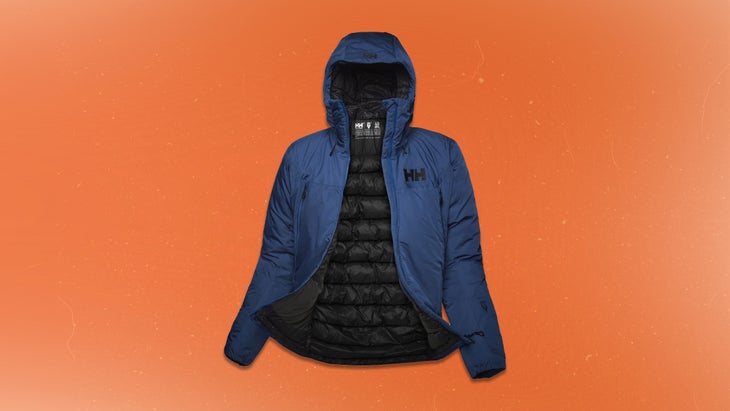
Best: For wet and very cold days
Weight: 2 lbs (men’s) / 1.9 lbs (women’s)
Size: Men’s S-2XL / Women’s XS-XL
Helly Hansen collaborated with Squamish Search and Rescue in rainy British Columbia to build this jacket, and it shows. The Odin is packed with balls of the brand’s trademarked Lifaloft fill (insulation is softer in ball form than in sheet form), along with sheets of warmer Primaloft Crosscore, all underneath a proprietary PFC-free water-resistant shell. The jacket also has a lining made of Graphene, which has long been known as the most durable material on the market, but which researchers recently figured out is also very heat conductive. The result: an extremely warm belay parka that’s so weather-protective we imagine we could take it for a swim and still not get cold. During low-20s ski tours in Alaska’s Chugach Range, it took on everything from fluffy snow to fat, wet flakes and kept us warm in the process. Another of our testers wore the Odin Lifa during belays and transitions (i.e., standing still) while ice climbing on a single-digits day in the San Juan Mountains and was perfectly comfortable. Befitting its belay jacket bonafides (and considering its insulation type), it’s not packable—think small watermelon—so this isn’t for trips when every gram and inch of pack space counts. But when you know you’ll be standing still in cold, wet weather for long periods of time, that cozy bulk pays off.
Bottom Line: Need a belay jacket that stays warm in the absolute worst weather? This is the one.
Columbia Platinum Peak ($180)
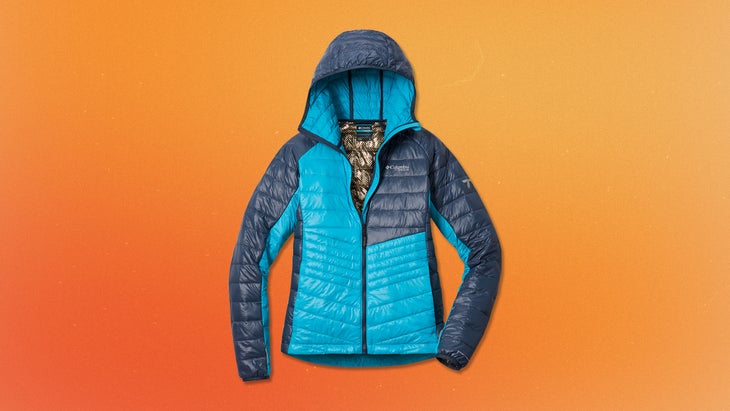
Best: Budget buy
Weight: 13.9 oz (men’s) / 11.9oz (women’s)
Size: Men’s S-2XL / Women’s XS-2XL
Our three testers were seriously impressed with the Platinum Peak’s warmth and packability, even without knowing it comes in at well under $200. That’s largely because its synthetic insulation gets a boost from Omni-Heat, Columbia’s proprietary metallic, heat-reflective lining. One tester wore this midweight puffy while snowshoeing in Colorado’s Sangre de Cristo Mountains in the mid-teens with just a midweight baselayer underneath and was totally comfortable. When he didn’t need it, the jacket packed away to the size of a cantaloupe (although not into its own pocket). We also found the Platinum Peak pretty durable: light bushwhacking in the Sangres was no challenge for the 20×25-denier nylon face fabric. The only tradeoff that you get for the price is in the features set: the Platinum Peak has only two zippered hand pockets and an interior pocket (big enough for your phone) and the hood isn’t adjustable, but it’s fine if you’re not wearing a helmet.
Bottom Line: An impressively warm and packable puffy for less than $200.
Patagonia AlpLoft Down Parka ($599)
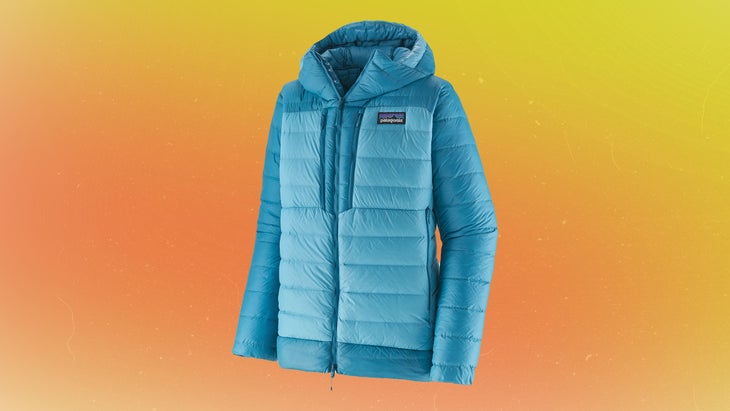
Best: For serious cold
Weight: 13 oz (men’s M)
Size: Unisex 2XS-2XL
The AlpLoft’s relatively low-bulk silhouette belies its true warmth thanks to some fancy baffle tech. Rather than two pieces of fabric stitched together to form the baffles, Patagonia’s designers wove the down chambers together, eliminating the seams that could cause leaking down and cold spots. We’ve seen this construction before, but never in a jacket of this warmth; most sub-zero parkas still use a box-wall construction, which requires more material and stitching, and creates bulk. As a result, the AlpLoft is much sleeker than the rest of its warmth class, with no detriment to its insulative properties. It proved itself during a trip to the Sierra Nevada for some single-digit camping, and again on the summit of Washington’s Mount Adams when temps dropped just below zero with the wind chill even lower. The whole thing is protected by a beefy 20-denier nylon ripstop with a PFC-free DWR. Our tester especially appreciated the plethora of storage options: Two hand warmer pockets, two chest pockets, and two internal drop pockets.
Bottom Line: When you really need to stay warm, but don’t want to look like the Michelin man.
Ortovox Swisswool Col Becchei Hybrid Jacket ($400)
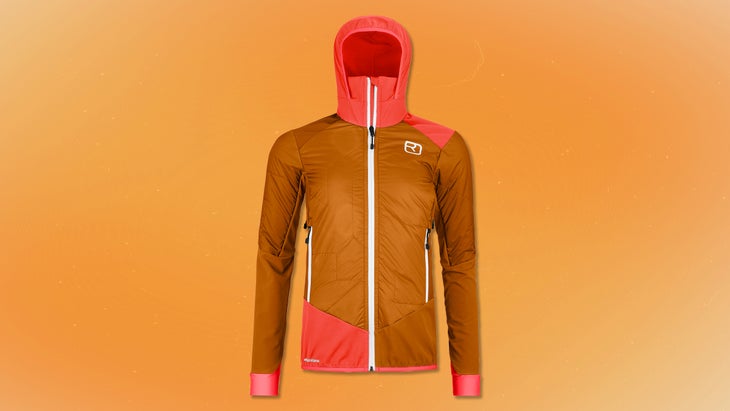
Best: For packability
Weight: 12.4 oz (men’s) / 11.3 oz (women’s)
Size: Men’s S-2XL / Women’s XS-XL
The Swisswool hits a sweet spot of insulation: just enough to provide warmth in high-20s temps without sacrificing pack space (The jacket scrunches down into its own spaghetti-squash sized pocket and weighs just over 12 ounces). That’s because designers used two different weights of merino fill, to provide insulation only where it matters, thus reducing bulk. A heavier stuffing fortifies the chest and upper arms, and a lighter, stretchier one sits everywhere else. That’s all covered with a breathable polyamide-merino-elastane face fabric. The result kept our Idaho-based tester warm while ski touring on a mid-teens day in the Coeur d’Alene Mountains, without overheating. Ortovox kept the features set minimal as well: two front pockets, a slim but stretchy hood, and lightweight pit zips that don’t add bulk. Even so, we hardly needed the extra ventilation. The wool was unsurprisingly good at moving moisture on its own, even when temps rose into the mid-30s. It’s also naturally stink-avoidant, which is good news considering the jacket’s slightly high-maintenance laundering instructions. Ding: price. Spending $400 might be worthwhile for those who routinely pursue big objectives where every ounce matters, but is less necessary for those who can stand to add a few ounces to their packs.
Bottom Line: An extremely breathable active layer with a supreme weight-to-packability ratio
Mammut Albula IN Hooded Jacket ($219)
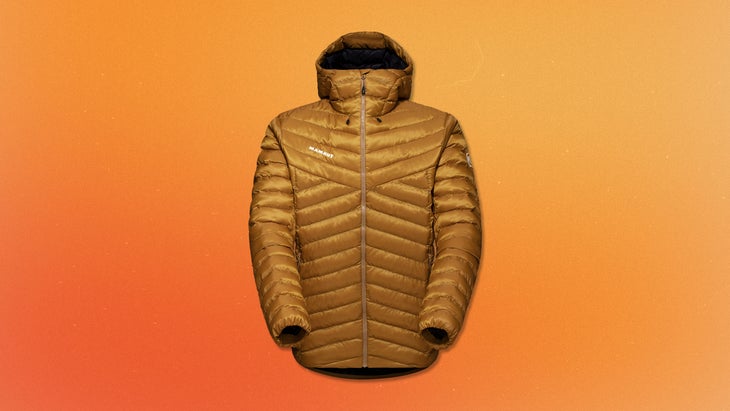
Best: Sustainable puffy
Weight: 1 lb (men’s) / 8 oz (women’s)
Size: Men’s S-3XL / Women’s XS-2XL
The basic midweight down puffy has been a crowd-pleasing staple of many brands’ lineups for years; this type of jacket is neither the warmest nor the most breathable, but it’s the one that many of us use on a daily basis. Here’s a take on that archetype, with plenty of added sustainability cred. The polyester shell fabric and synthetic Ecodown filling are both made from 100 percent recycled materials (the Ecodown uses post-consumer plastic) and the DWR treatment is PFC-free. Its manufacturing processes are also certified by both Fair Wear and Bluesign. And its performance rocks. Cinch adjustments held the hood in place through 20 mile-per-hour winds on a 10,500-foot northern Colorado summit, and the moisture-resistant insulation stayed lofty and cozy during a sleet-plagued multi-day raft trip in southern Utah. Meanwhile, the fit allows for layers underneath, making it versatile enough for both 25-degree ski-tour transitions and 50-degree spring campouts.
Bottom Line: The fan-favorite midweight puffy, made sustainably.
Marmot WarmCube Active Alt HB ($350)
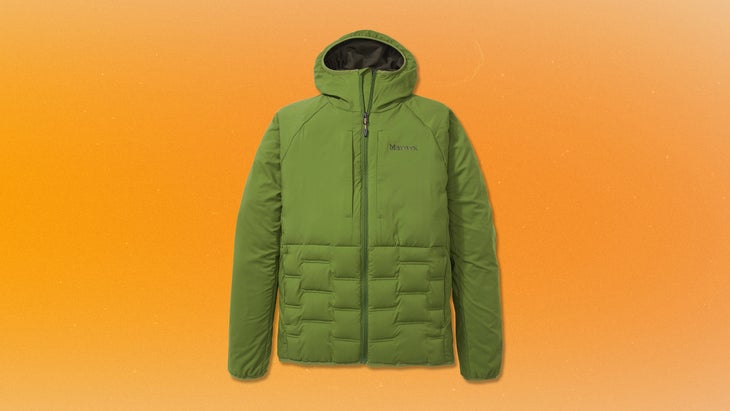
Best: Breathable heavyweight
Weight: 13 oz (men’s M)
Size: Men’s S-2XL / Women’s XS-XL
Most uberpuffies are made for hunkering down, not striding forth. But this amply-insulated jacket builds breathability into the equation. Warmth comes from square baffles containing 700-fill water-resistant down. Breathability comes from the wide, welded channels separating the baffles. They promote airflow and help move moisture, which commutes through those channels rather than dampening the plumes and compromising heat retention. The resulting ventilation is sufficient for low-output activity but aggressive skiing or running will still steam it up. So, consider this a summit puffy with some aerobic wiggle room. Our Minnesota tester deemed it ideal for walks in extreme cold (like eight degrees with wind). Stretch fabric makes it unconfining enough for comfortable pole-plants while snowshoeing or hiking in sub-freezing temps.
Bottom Line: A superwarm down jacket that’s breathable enough for slow hikes
Mountain Equipment Shelterstone Jacket ($275)
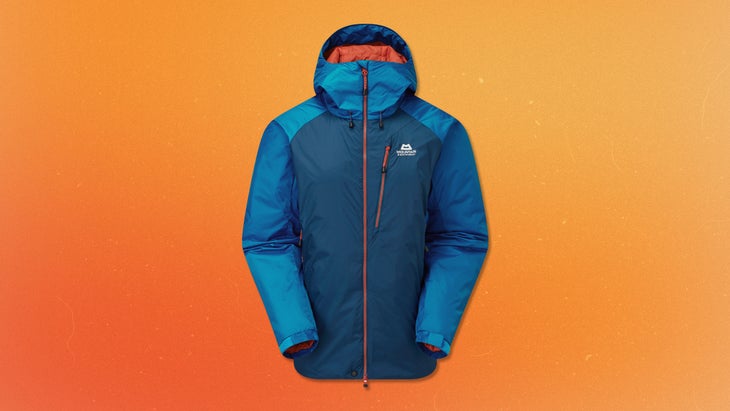
Best: Midweight for wet weather
Weight: 1 lb 5 oz (men’s) / 1 lb 4 oz (women’s)
Size: Men’s S-2XL / Women’s 8-16
Want a puffy that performs like a hard shell in soggy weather? Here’s your answer: The Shelterstone’s 40-denier nylon shell fabric is windproof and virtually waterproof, as our tester discovered during a freezing downpour near Duluth. Sustained rain in temps above 40 degrees did soak through the cuffs and seams, but snow and sleet just beaded off the fabric, which is treated with a PFC-free DWR. Fully recycled synthetic insulation (115-gram in the body and 80-gram in the hood) was plenty to keep us warm from 0 to 30 degrees along Minnesota’s North Shore. Meanwhile, the wire-brimmed hood actually stays put in gusts (not all do!) and includes a tall, chin-shielding collar. The seaming allowed testers to raise their arms without exposing midriff. And five total pockets (including an interior drop pouch and Napoleon pocket) held phones, neck gaiters, snacks, sunscreen, inclinometers. Insulated hand pockets swallowed trekkers’ icy digits.
Bottom Line: This midweight lets you leave home without a hard shell, even when wintry weather is in the forecast.
Cotopaxi Capa Insulated Jacket ($235)
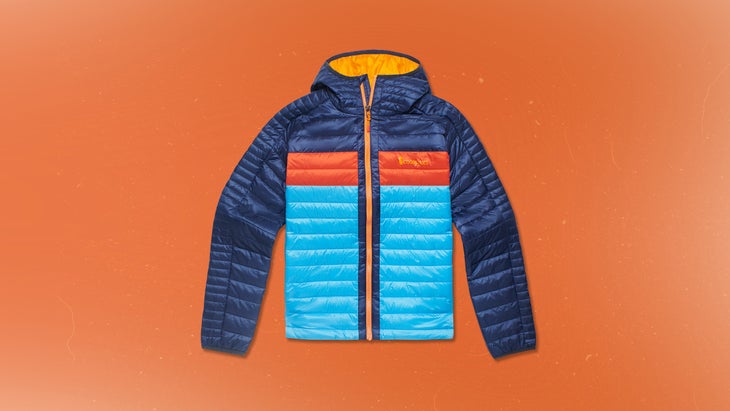
Best: Everyday puffy
Weight: 12 oz (men’s)
Size: Men’s S-3XL / Women’s 2XS-2XL
Sure, this puffy looks cool, thanks to Cotopaxi’s trademark colorblocking. But it’s more than just a pretty face: Fully recycled abrasion and puncture-resistant 20-denier nylon surrounds Primaloft Gold P.U.R.E. synthetic insulation, which skips the traditional high-heat bonding process and thus saves 48 percent on carbon emissions compared to standard synthetic fills. All together, this yields a fashionable coat with enough technical cred for soggy-climate adventure (synthetic insulation stays warm when wet). One tester took it on a sweaty outing through overgrown, scrubby trail in sleety conditions, and came home warm and dry. Thin baffles make it best for temps above 40 degrees Fahrenheit, and an impressive size range fits a wide range of bodies.
Bottom Line: Sustainable and versatile, here’s the one puffy you need for town and backcountry.
Patagonia SugarDown Hoody ($329)

Best: Natural insulation
Weight: 13 oz
Size: Men’s XS-2XL / Women’s 2XS-XL
The SugarDown takes natural insulation to the next level: In addition to 800-fill RDS goose down, the jacket features a 12-denier ripstop PFC-free DWR-treated shell and liner fabric derived entirely from sugarcane. And it performs. Our tester packed the jacket down to the size of a can of Pringles, and found it comfortable from about the freezing mark up into the high 50s—less if moving hard. Features are simple: The hood is snug (not big enough for a helmet), and there are two handwarmer pockets and a chest pocket. During a four-day river trip on the Blackfoot in Montana, our tester had no issue with quick rain or snow showers, but real rain got through. However, it did handle wind impressively.
Bottom Line: A down jacket with a wide temperature range and high sustainability cred
Eddie Bauer EverTherm Downdraft Hooded Jacket ($299)
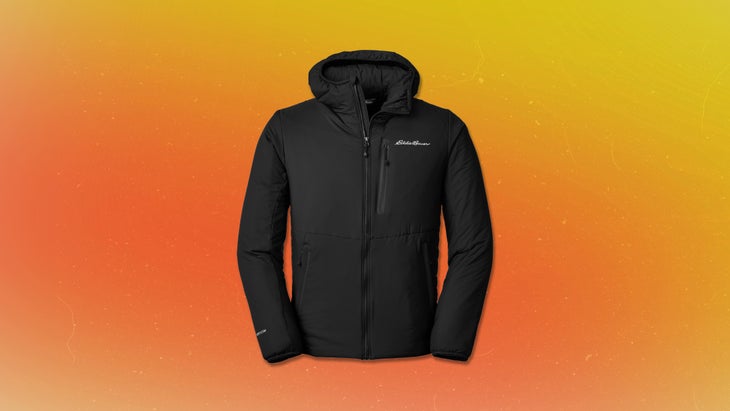
Best: Imitation-down jacket
Weight: 13.6 oz (men’s M) / 11.8 oz (women’s S)
Size: Men’s S-2XL / Women’s XS-2XL
Synthetic insulation is often laid into a self-contained sheet, as opposed to down’s loose feathers. That prevents leaking and enables designers to use lighter face and liner fabrics. Eddie Bauer was the first brand to mimic this with actual down, with its ThinDown insulation in 2017. We’ve tested many layers equipped with the technology, and have consistently found it to be an effective insulator at a fraction of the bulk. This latest addition to the family uses a super air-permeable 20-denier nylon face fabric to hold it together, boosting breathability. While ski touring in Colorado’s San Juan Mountains, our tester wore the jacket for the above-treeline portion of a 1,000-foot skin on a cloudy, low-teens day. When it came to standing still, this jacket wasn’t as warm as other puffies, but it was just right into the low 30s.
Bottom Line: You’d be hard pressed to find a slimmer down jacket that’s more comfortable while moving.
Reviews: The Best Midlayers of 2023
Jack Wolfskin Alpspitze Insulated Hoody ($229.95)
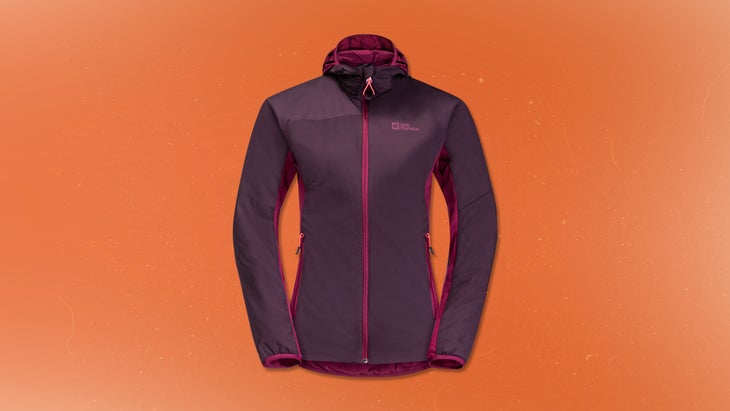
Best: For breathability
Weight: 13 oz (men’s) / 10 oz (women’s)
Size: Men’s S-2XL / Women’s XS-XL
Our team’s most reliable way of testing a jacket’s breathability is taking it touring inbounds at the local resort. Climbs are steep and consistent, breaks are more limited than while touring in the backcountry, and other variables like weird snow are nonexistent. Touring up Pennsylvania’s Whitetail Mountain is where the slim-fitting Alpspitze really shone, in temps as high as 40 degrees. Our tester confirmed that designers paired just enough Primaloft Active Gold with a light grid fleece under the arms and on the sides to keep moisture moving, including back sweat—even with a pack on. The parts of the jacket that did get a little damp were dry before he could finish his transition back downhill. Meanwhile, the polyamide (similar to nylon) face fabric blocked just enough breeze to keep our testers from getting chilled without inhibiting ventilation. When you’re not wearing the Alpspitze (rare, according to our Pennsylvania tester), it’s about grapefruit-sized.
Bottom Line: Moving hard and fast? Nothing we tested took care of moisture as well as the Alpspitze.
Montane Fireball Lite Hoody ($259)
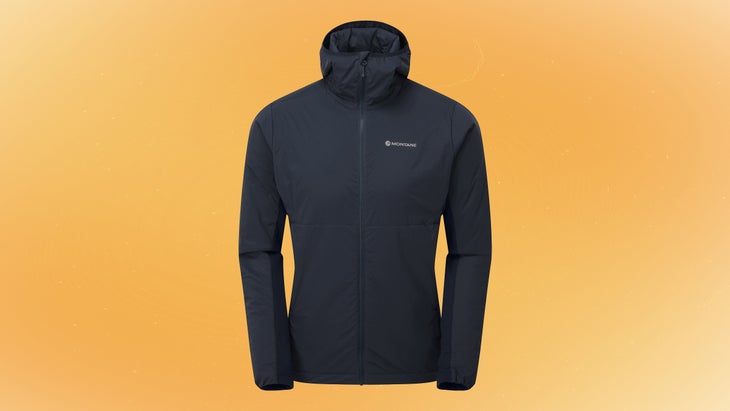
Best: All-around midlayer
Weight: 12.7 oz (men’s) / 11.3 oz (women’s)
Size: Men’s S-2XL / Women’s XS-XL
The Fireball might have gotten the most use of any jacket in our testing lineup this year, simply because of how versatile it is. One tester wore the active insulator everywhere: fall desert camping trips (over a t-shirt when temps climbed into the low 60s), single-digit midwinter ski tours in the San Juan Mountains, damp climbs in the Cascades. How did it handle all of these situations? With a body-mapped combination of lightweight proprietary synthetic insulation and super-stretchy grid fleece. On their own, neither of these materials are unique. The magic is in how they’re proportioned: just the right amount of insulation around the core, and fleece under the arms and down the sides. The result is slightly warmer than the Jack Wolfskin Alpspitze, but covers a wider temperature range, so it functions as a primary outer layer when it’s warm and as a moisture-moving midlayer when it’s cold. The 13-denier nylon-polyurethane outer is air-permeable when it’s exposed or glides easily under other jackets.
Bottom Line: If you need one jacket that fits into your system no matter the mission, it’s probably the Fireball.
Flylow Mia Jacket ($280)
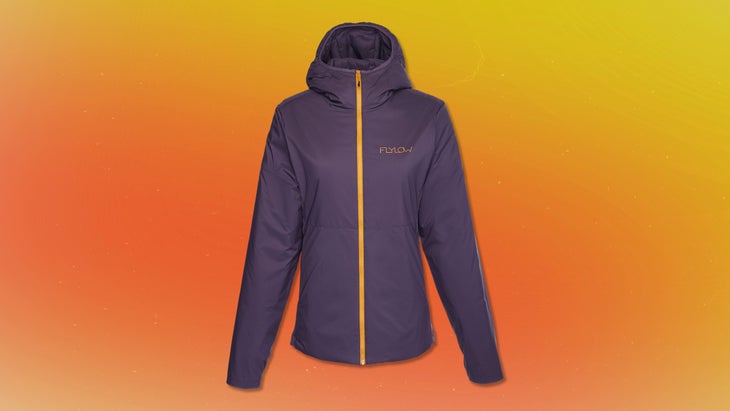
Best: women’s-specific midweight
Weight: 9 oz
Size: Women’s XS-XL
Women may run colder than men, but we still sweat—so Flylow optimized this jacket’s insulation and breathability for female ski tourers. This winter’s version bumps up the warmth throughout the chest and core (from 60-gram to 80-gram recycled Greenloft synthetic insulation), but adds ventilation under the arms, courtesy of supremely breathable stretch-fleece panels that banish interior moisture. The makeup served testers while hiking in temperatures ranging from 8 to 34 degrees. One remained steam-free during speedy bootpacks in 18-degree weather up Aspen’s steep Highland Bowl, where 25 mile-per-hour gusts raked the ridgeline and the Pertex Quantum Air shell fabric earned props for its wind protection. “It’s rare that I can put on a jacket and keep it on,” said another tester, “But the Mia kept me from riding the temperature roller-coaster so I didn’t have to make lots of layer changes.”
Bottom Line: Here’s the extra insulation that women need to stay warm while hiking, with plenty of breathability to keep them dry while charging hard.
LeBent Pramecou/Genepi Wool Insulated Hybrid Jacket ($380)
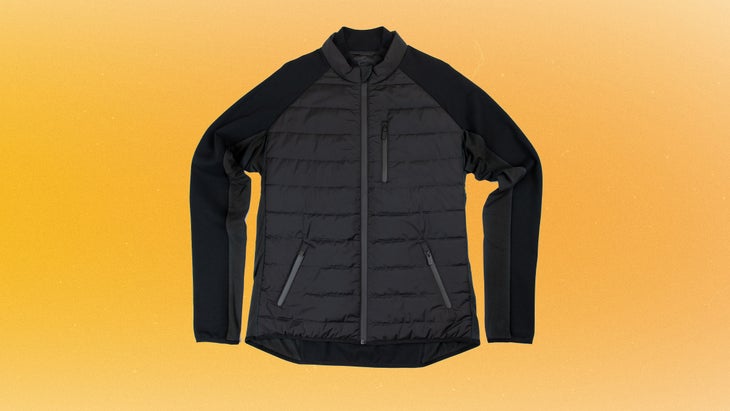
Best: For freedom of movement
Weight: 1 lb 7 oz (men’s) / 1 lb 1 oz (women’s)
Size: Men’s S-XL / Women’s XS-L
Two qualities make this hybrid stand out from the pack. One is a wool-based construction: padded chest panels filled with a 100-gram blend of 30 percent wool with recycled polyester, plus a gridded wool/bamboo rayon lining that limits odor. Testers enjoyed stink-free wear for weeks between washings. Fit is the other: The stitch lines are positioned across the back of the arms where they don’t restrict reach, yielding best-in-test freedom of movement (the stretch jersey panels around the shoulders and underarms also help). The result is a jacket that seems to disappear on your body, while buffering gusts and dumping sweat. The wool insulation kept testers warm during 12-degree tours, and the 10K/10K shell fabric delivers the ideal blend of waterproofness and breathability (snow never soaked through, yet the jacket ably managed sweat while we were breaking trail through fresh drifts). Testers in dry northern Colorado and misty Greenland alike deemed it the perfect combo for 10- to 30-degree tours in breezy conditions. Three zippered pockets (two hand, one chest) keep snacks and a phone at the ready.
Bottom Line: You’ll forget you’re wearing this jacket—and that’s a good thing.
Dæhlie Conscious Jacket ($280)
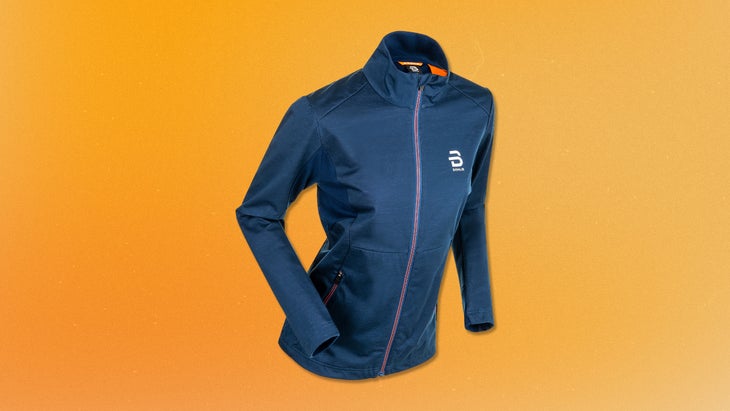
Best: Ultralight for aerobic pursuits
Weight: 1 lb 2 oz (men’s) / 1 lb (women’s)
Size: Men’s S-2XL / Women’s XS-XL
Perpetual-motion workouts call for minimal insulation and maximum breathability. Both are this hoodless jacket’s strong suits. The three-layer fabric sandwich is exceptionally thin and supple. A tencel-merino mesh lining with a recycled polyester membrane blocks wind (with a 6,000mm waterproof rating, it also holds off light rain and sleet) and a tencel-merino jersey face fabric offers a smidge of warmth. It’s just right for go-fast missions on skate or touring skis, and the trail runners in our test crew also made it a mainstay. All camps applauded the stretchy ventilation panel down the center back, which dumps sweat while promoting unfettered reach. Undyed fabric saves water (more than 90 liters per garment according to the brand) and a sustainable, fluorocarbon-free water-repellant finish repels flurries.
Bottom Line: Appealingly minimal and sustainably-made, consider this your new training partner.
Smartwool Intraknit Merino Sport Full Zip Jacket ($200)
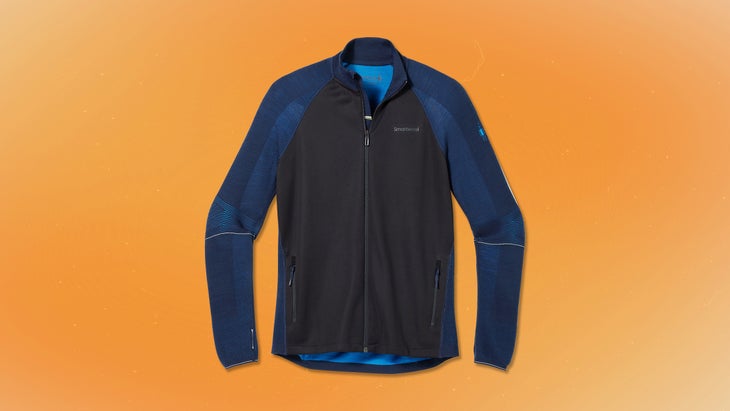
Best: Merino midlayer
Weight: 13 oz (men’s) / 12 oz (women’s)
Size: Men’s S-2XL / Women’s XS-XL
Dazzlingly versatile, this hoodless midweight scored high points for breathability, thanks to an airy low-bulk Merino jersey (blended with 53 percent synthetic fibers) topped with a 100-percent polyester windproof reinforcement on the front panels. The go-everywhere layer kept testers warm during speedy descents on Nordic skis (when worn alone over a base layer) and on chilly lift rides (when layered beneath a resort jacket). The short, stretchy collar seals in body heat and interfaces smoothly with neck gaiters and hooded shells. Two hand pockets hold a neck gaiter or energy bar. Though it’s not as odor-foiling as fabrics with greater wool content, it’s silky-soft and quick to dry, making it a tester favorite for hard-charging hikes, cold runs, and cross-country skiing.
Bottom Line: Midlayers rarely excel across multiple sports like this one.
Reviews: The Best Fleeces of 2023
Editor’s Choice: Black Diamond Coefficient LT Hybrid Hoody ($180)
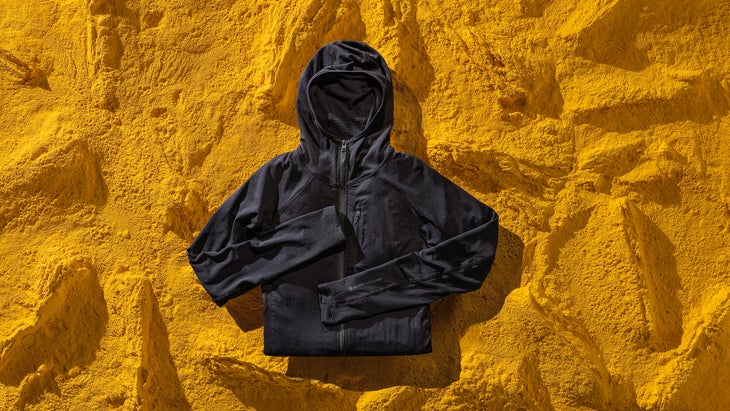
Weight: 7 oz (men’s and women’s)
Size: Men’s and Women’s S-XL
A Zen master must have designed this jacket. Because instead of stuffing it with more insulation, more pockets, or more fancy features, Black Diamond stripped away everything but the essentials. What remains is a lightweight, gridded-fleece hoody with a subtle layer of extra insulation and wind protection on the front. The result earned rave reviews from hard-charging ski mountaineers who feel that Black Diamond’s definition of just-enough is just right.
The jacket’s appeal begins with the stretchy polyester Polartec Powergrid fleece that’s used everywhere but in the front panels. The gridded jersey is so light and airy that it’s see-through. In practice, this meant it kept pace with one tester’s ample sweat output as she charged up steeps in Colorado’s Elk Mountains on several 30 to 35-degree days. But the interior’s tiny tufted squares also provide a hint of insulation.
Up front, a thin layer of 40-gram Primaloft Silver synthetic insulation topped with ultralight stretch-woven nylon boosts the thin fleece’s R value enough to keep testers comfortable in temps starting just below freezing. One tester deemed this the perfect combination for windy, 40-degree conditions atop Pearl Pass, while another preferred it for high-wattage uphills in mid-20 degree temperatures. Both reached for it on days that called for wearing more than just a base layer—but not too much more. When topped with a shell, the Coefficient LT kept hikers comfortable down to 10 degrees.
Though few, the features are smart: thumb loops on the cuffs, a stretchy hood that fits over a ball cap for added protection against wind and sun (it’s not, however, helmet compatible). The sole zippered pocket on the chest stores a phone or inclinometer within easy reach.
All together, the airy fabric and minimal feature set yield a finished product that weighs just seven ounces—so light that we routinely forgot about it, whether it was on our person or in our packs. Can forgettability be an attribute? When evaluating technical apparel, we consider it the highest praise.
Bottom line: This jacket’s genius is its restraint.
Mountain Hardwear Polartec Power Grid Full Zip Hoody ($160)
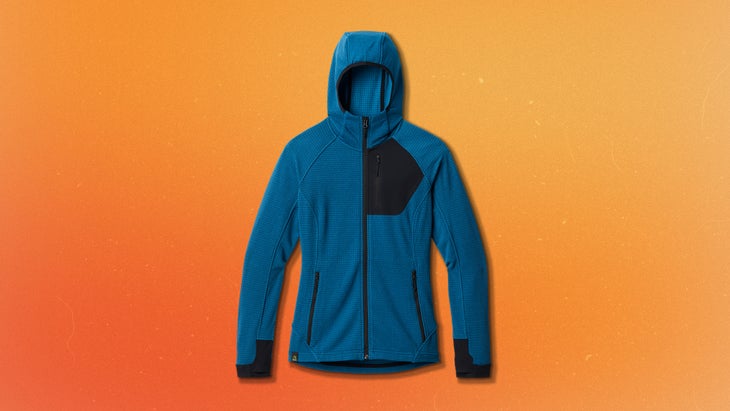
Best: All-around fleece
Weight: 15 oz (men’s) / 13.6 oz (women’s)
Size: Men’s S-2XL / Women’s XS-XL
The world of tech fleeces is admittedly vast, with just about every brand trying to take a bite out of the much-lauded Patagonia R1. This Mountain Hardwear jacket features a few incremental, but very real improvements. It starts with Polartec Power Grid throughout, which our tester found to be the perfect weight for fall rock climbing in Moab, and adds a full-length zip, boosting versatility. We also loved the ultra-comfortable thumb loops and cuffs, which feature a super soft and stretchy polyester, as well as the raglan sleeves that spill in a single piece from the top of the shoulders to the arms for enhanced mobility. The jacket features two hand warmer pockets and a chest pocket, as well as an oh-so-perfect hood that was just the right amount of snug without a helmet but still stretched to accommodate one.
Bottom Line: There’s not much left to improve on this comfy, functional, and versatile grid fleece.
Sponsor Content
Fjällräven Keb Fleece Hoodie ($195)
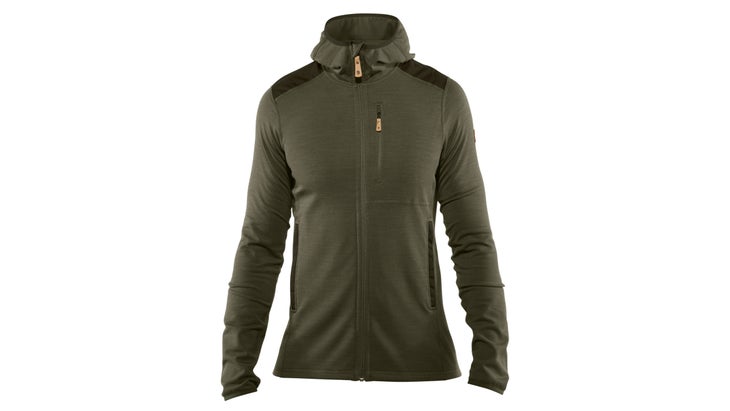
Brave the chill in this functional fleece midlayer from Fjällräven. With the dynamic ability to insulate while wicking away moisture, the Keb Fleece Hoodie is perfect for year-round use whether you’re paddling, trekking, or ski touring. The three zippered pockets are designed to store items securely and the wool blend is comfortable and lightweight to travel with you to all of life’s highpoints.
Icebreaker Quantum Hoody III ($220)
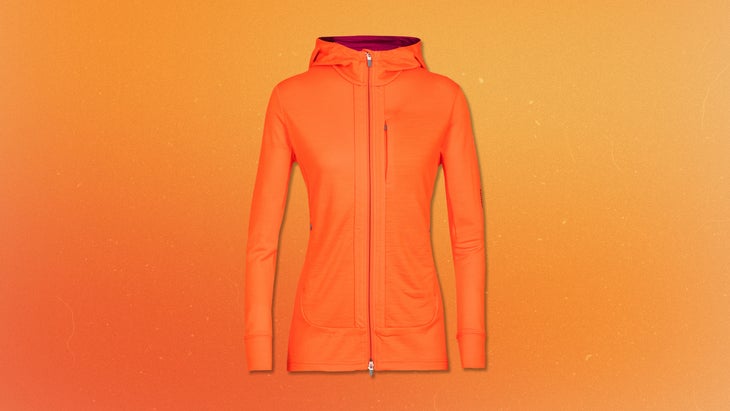
Best: Trail-to-town fleece
Weight: 1.12 lb (men’s) / 14.6 oz (women’s)
Size: Men’s S-2XL / Women’s XS-XL
Take your favorite ultra-cozy hoodie and add a few technical elements; that’s the Quantum. It has the silhouette and features of your standard full-zip hoodie—roomy hood, hand pockets and chest pocket, easy to use zipper, thumb loops—and it’s as soft and plush as any sweatshirt you’ve ever worn. The difference: It’s 100 percent merino wool. Our tester used his liberally for short hikes around his house atop Log Hill Mesa in Colorado’s San Juans on days in the 40s and 50s. It handled sweat beautifully and stayed warm even after a short rain shower. But it’s just as cozy around the house on winter mornings or wearing into town for a beer on a spring afternoon. And unlike your old favorite sweater, it stays just as soft after its first couple washes.
Bottom Line: An everyday fleece that’s as comfortable as a sweatshirt
Sitka Ambient Jacket ($300)
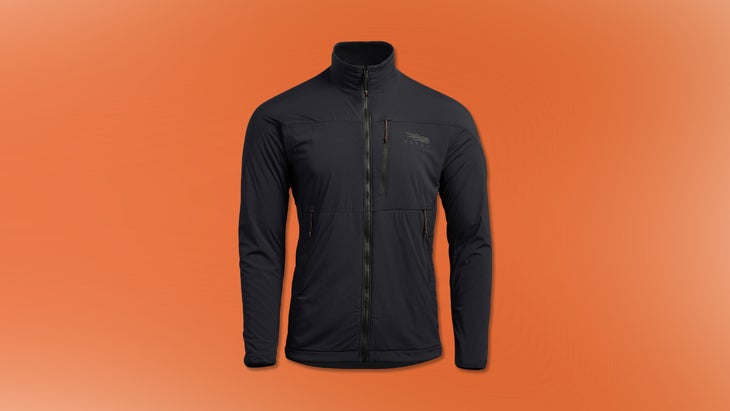
Best: Shelled fleece
Weight: 18 oz (men’s) / 15 oz (women’s
Size: Men’s M-2XL / Women’s S-XL
We love fleece for its sweat-wicking superpowers, but this jacket levels up the basic synthetic-pile formula. It uses150-gram PrimaLoft Evolve fleece, which deploys pile fibers of varying heights to promote breathability and warmth, and tops that with a stretchy, DWR-treated nylon shell that repels drizzle and flurries. Thus the Ambient proved itself an optimal layer through wet weather that would have soaked regular fleeces (or necessitated the addition of a water-shedding shell). This set-and-forget jacket kept testers dry and regulated on a snowy 32-degree day in western Pennsylvania, on blustery 40-degree outings in southern New York, and on 15-degree ridgelines in northern Colorado. Three pockets provide convenient accessory storage, and the jacket packs to a tidy soccer-ball size.
Bottom Line: This stretchy fleece has rain-shedding superpowers and uncompromised breathability.
How to Buy Puffy Jackets and Midlayers
Which midlayer is right for you depends on how you plan to use it. Synthetic insulators are bulkier, but better in wet weather; down ones are lighter and more packable but lose their warmth when wet. If you’re outfitting yourself for mostly aerobic activities, look for more lightly insulated layers that use stretchy, breathable face fabric. If you’re looking for a jacket to wear standing around in cold temps, seek out more heavily insulated layers with durable, wind-resistant fabric, a large adjustable hood, and ample pockets.
How to Buy Fleeces
Fleeces fall into two main genres: technical ones for active pursuits, and plush ones for hanging out. If you’re looking for something to wear skiing, climbing, or hiking, look for something with relatively low loft (as opposed to something shaggy, which will trap more heat). Grid patterns or other highly air-permeable options like Polartec Alpha will be best at moving sweat. Features like helmet-compatible hoods, thumb loops, and water- or wine-resistant face fabrics are worth the upgrade depending on how you plan to use the fleece. If you’re looking for a fuzzy layer to wear around the campfire, look for something simple and roomy—so you can easily pull it over whatever other layers you’re wearing. Features like durable nylon elbow patches, wind-resistant linings, and deep pockets can add welcome durability and comfort.
